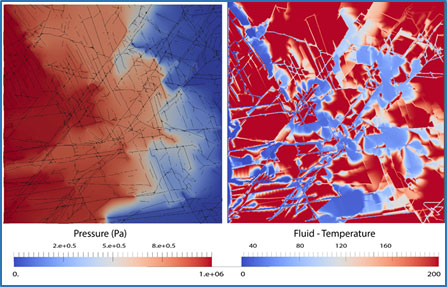GEOTHERM-2

|
GEOTHERM-2 conducts cross-disciplinary research towards the development of Enhanced Geothermal Systems (EGS). EGS is a technology that will allow the heat resources residing at several kilometers depths to be exploited for electricity and heat production. At present, EGS technology is not mature; two of the key challenges are the difficulty of (1) engineering a lasting heat exchanger with appropriate properties within deep, hot, low-porosity rocks, and (2) the risk of inducing felt and potentially hazardous seismic events during the development and operation of the heat exchanger. GEOTHERM-2 continues the work initiate in the GEOTHERM-1 project (2009-2012). The project was conceived in order to provide a bridge to a major nationwide project in geothermal energy, the Swiss Competence Center Energy Research-Supply of Energy (SCCER-SoE), that was in its planning phase when GEOTHERM-2 was proposed, and has begun in the meantime. In total thirty eight co-workers from various Departments and Institutes in ETH and in EPFL, and of the Paul Scherrer Institute contribute to the project. The main strength of GEOTHERM-2 is to adopt a cross-disciplinary approach to the challenges mentioned above. The contributions of GEOTHERM-2 in terms of scientific results, capacity building and knowledge transfer are a therefore critical intermediate step towards successful future Pilot and Demonstration projects, and complement the activities conducted in SCCER-SoE. The research activities in GEOTHERM-2 are organized in six Modules or work packages, which are designed to:
|
|---|---|
| Chef de projet au SED | Prof. Dr. Stefan Wiemer |
| Membres du projet au SED | Prof. Dr. Stefan Wiemer, Dr. Alba Zappone, Dr. Laurentiu Danciu, Dr. Pierre Dublanchet, Dr. Valentin Gischig, Dr. Dimitrios Karvounis, Eszter Király, Dr. Toni Kraft, Lukas Heiniger, Marcus Herrmann, Dr. Anne Obermann, Dr. Arnaud Mignan, Barbara Schechinger |
| Source de financement | Competence Center Environment Sustainability (CCES), Competence Center Energy and Mobility (CCEM) and Bundesamt Für Energie (BFE) |
| Durée | 2013 - 2016 |
| Mots-clef | Energy, geothermy, multidisciplinary |
| Domaine de recherche | Induced Seismicity, Geomechanics, Geochemistry, energy conversion systems, Social Acceptance |
| Website | http://www.sccer-soe.ch/research/geo-energy/task1.2/geotherm-2/ |
Deichmann N., Kraft T. and Evans K.F. (2014). Identification of faults activated during the stimulation of the Basel geothermal project from cluster analysis and focal mechanisms of the larger magnitude events. Geothermics 52, 84-97. doi: 10.1016/j.geothermics.2014.04.001
Driesner, T. (2013). The Molecular-Scale Fundament of Geothermal Fluid Thermodynamics. Reviews in Mineralogy and Geochemistry 76, 5-33. doi: 10.2138/rmg.2013.76.2
Gischig, V., and Wiemer, S. (2013). A stochastic model for induced seismicity based on non-linearpressure diffusion and irreversible permeability enhancement. Geophys. J. Int.. doi: 10.1093/gji/ggt164
Hillers, G., Husen, S., Obermann, A., Planès, T., Campillo, M. and Larose, E. (2015). Noise based monitoring and imaging resolve reservoir dynamics associated with the 2006 Basel injection experiment. Geophysics 80(4), 51-68. doi: 10.1190/GEO2014-0455.1
Hingerl, F.F., Kosakowski, G., Wagner, T., Kulik, D.A. and Driesner, T. (2014). GEMSFIT: a generic fitting tool for geochemical activity models. Computational Geosciences 18(2), 227-242. doi: 10.1007/s10596-014-9405-3
Hingerl, F.F., Wagner, T., Kulik, D.A., Thomsen ,K. and Driesner, T. (2014). A new aqueous activity model for geothermal brines in the system Na-K-Ca-Mg-H-Cl-SO4-H2O from 25 to 300°C. Chem. Geol. 381, 78-93. doi: 10.1016/j.chemgeo.2014.05.007
Hirschberg, S., Wiemer, S. and Burgherr, P. (2015). Energy from the earth: Deep geothermal as a resource for the future?. TA-Swiss, Bern, Switzerland, 220-251.
Kaiser, P.K., Valley, B., Dusseault, M.B. and Duff, D. (2013). Hydraulic Fracturing Mine Back Trials – Design Rational and Project status. In: Bunger, A.P., McLennan, J. and Jeffrey, R. : Effective and sustainable hydraulic fracturing. InTech. doi: 10.5772/56260
Kraft, T. and Deichmann, N. (2014). High precision relocation and focal mechanism of the injection induces seismicity at the Basel EGS. Geothermics 52, 59-73. doi: 10.1016/j.geothermics.2014.05.014
Obermann, A., Kraft, T., Larose, E. and Wiemer, S. (2015). Potential of ambient seismic noise techniques to monitor reservoir dynamics at the St. Gallen geothermal site (Switzerland). JGR. doi: 10.1002/2014JB011817
Preisig, G., Eberhardt, E., Gischig, V., Roche, V., van der Baan, M., Valley, B., Kaiser, P.K., Duff, D. and Lowther, R. (2015). Development of connected permeability in massive crystalline rocks through hydraulic fracture propagation and shearing accompanying fluid injection. Geofluids 15, 321-337. doi: 10.1111/gfl.12097
Rivera, J.A., Blum, P. and Bayer, P. (2015). Analytical simulation of groundwater flow and land surface effects on thermal plumes of borehole heat exchangers. Applied Energy 146, 421-433. doi: 10.1016/j.apenergy.2015.02.035
Spada, M., Sutra, E., Wolf, S. and Burgherr, P. (2014). Accident Risk Assessment for Deep Geothermal Energy Systems. In: Nowakowski, T., Mlynczak, M., Jodejko-Pietruczuk, A. and Werbinska-Woiciechowska, S.: Safety and Reliability: Methodology and Applications. Taylor and Francis Group, London UK.
Stauffacher, M., Muggli, N., Scolobig, A. and Moser, C. (2015). Framing deep geothermal energy in mass media: the case of Switzerland. Technological Forecasting and Social Change 98, 60–70. doi: 10.1016/j.techfore.2015.05.018
Weis, P., Driesner, T., Coumou, D. and Geiger, S. (2014). Hydrothermal, multiphase convection of H2O-NaCl fluids from ambient to magmatic temperatures: a new numerical scheme and benchmarks for code comparison. Geofluids 14(3), 347-371. doi: 10.1111/gfl.12080
Zezin, D., Driesner, T. and Sanchez-Valle, C. (2015). Volumetric Properties of Na2SO4–H2O and Na2SO4–NaCl–H2O Solutions to 523.15 K, 70 MPa. J. Chem. Eng. Data 60(4), 1181–1192. doi: 10.1021/je501152a
Zezin, D., Driesner, T. and Sanchez-Valle, C. (2014). Volumetric Properties of Mixed Electrolyte Aqueous Solutions at Elevated Temperatures and Pressures. The System KCl–NaCl–H2O to 523.15 K, 40 MPa, and Ionic Strength from (0.1 to 5.8) mol·kg–1. Journal of Chemical and Engineering Data 59, 736-749. doi: 10.1021/je400761c